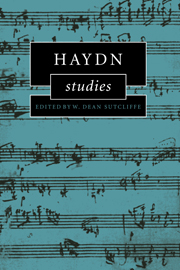Book contents
- Frontmatter
- Contents
- Preface
- Editor's note
- 1 The consequences of presumed innocence: the nineteenth-century reception of Joseph Haydn
- 2 Haydn's sacred vocal music and the aesthetics of salvation
- 3 Sentiment and sensibility in La vera costanza
- 4 Haydn as Romantic: a chemical experiment with instrumental music
- 5 Haydn's ‘Cours complet de la composition’ and the Sturm und Drang
- 6 Haydn's reversals: style change, gesture and the implication-realization model
- 7 Haydn's symphonies between Sturm und Drang and ‘Classical style’: art and entertainment
- 8 The Haydn piano trio: textual facts and textural principles
- 9 Papa Doc's recap caper: Haydn and temporal dyslexia
- 10 Haydn: the musicians' musician
- Index
7 - Haydn's symphonies between Sturm und Drang and ‘Classical style’: art and entertainment
Published online by Cambridge University Press: 22 September 2009
- Frontmatter
- Contents
- Preface
- Editor's note
- 1 The consequences of presumed innocence: the nineteenth-century reception of Joseph Haydn
- 2 Haydn's sacred vocal music and the aesthetics of salvation
- 3 Sentiment and sensibility in La vera costanza
- 4 Haydn as Romantic: a chemical experiment with instrumental music
- 5 Haydn's ‘Cours complet de la composition’ and the Sturm und Drang
- 6 Haydn's reversals: style change, gesture and the implication-realization model
- 7 Haydn's symphonies between Sturm und Drang and ‘Classical style’: art and entertainment
- 8 The Haydn piano trio: textual facts and textural principles
- 9 Papa Doc's recap caper: Haydn and temporal dyslexia
- 10 Haydn: the musicians' musician
- Index
Summary
The traditional narratives of Haydn's symphonic career view him as having developed gradually: from modest and to some extent conventional beginnings, through various phases of experimentation, to eventual mastery. In these accounts, two periods within his tenure at the Esterházy court stand out as high-points. Jens Peter Larsen finds that during the so-called Sturm und Drang, just before and after 1770, a ‘remarkable expansion of expression and compositional technique’ led to symphonies that ‘still impress for their striking sincerity and directness [and] in their own time … must have come as a revelation’ – led, indeed, to an already ‘Classical’ maturity. Then, in some respects prefigured by the string quartets Op. 33 (1781), the mid- and late 1780s witnessed the triumph of ‘Classical style’ proper in Haydn's orchestral music, specifically the Seven Last Words and the ‘Paris’ Symphonies, both of 1785–6.
By contrast, Haydn's symphonies that fall between the Sturm und Drang and the mid-1780s enjoy no comparably high reputation. Indeed, his stylistic ‘turn’ in the mid-1770s has been a distinct embarrassment for Haydn scholarship. Larsen regards it as a sort of let-down: ‘Haydn may have felt a need … to slow down after his years of intense exploration’, although he also speculates (not entirely consistently) that ‘a reaction on Prince [Esterházy's] part may have been the main cause of Haydn's moderating his progressive tendencies’.
- Type
- Chapter
- Information
- Haydn Studies , pp. 218 - 245Publisher: Cambridge University PressPrint publication year: 1998
- 35
- Cited by

